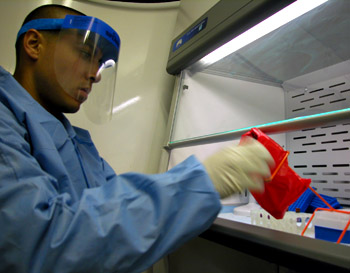Experts in Medicine
There is a well-documented trend of growth among black or African American female medical school graduates. Since 1986, the proportion of female graduates has increased 53%, and the proportion of male graduates has declined 39%.

Roscoe L Koontz designed a pinhole gamma ray camera called the collimator, and helped to design and fabricate automatic air and water radiation activity measuring devices. He was the first formally trained health physicist.
Health physics is a profession devoted to the protection of people and the environment from the harmful effects of radiation, thus providing for the utilization of radiation for the benefit of mankind. The profession, as we know it, began during World War II when the tremendous power available from nuclear energy was first being developed for weapons. The radiation hazards encountered during the early years of atomic energy were solved by the cooperation of physicists, chemists, biologists, engineers, and physicians. From this endeavor emerged the interdisciplinary specialty known as "health physics."
Roscoe L. Koontz was born in St. Louis, Missouri in 1922. Graduating from Vashon High School in St. Louis, Koontz spent three years in the army during World War II. While in the service, he received technical training through a special pre-engineering army training program at West Virginia State College. Upon discharge from the army in 1946, he returned to Tennessee State University and graduated with a Bachelor of Science in Chemistry.
Roscoe Koontz was among the first formally trained health physicists through his participation in the first Atomic Energy Health Physics Fellowship Training Program, sponsored at the University of Rochester in 1948. He designed a pinhole gamma ray camera and collimator and helped to design and fabricate automatic air and water sampling equipment and radiation activity measuring devices
As a graduate student at the University of Rochester, Roscoe Koontz conducted research on problems concerning neutron dosimetry, toxicology of uranium, plutonium and fission products. At Atomics International, a company in Southern California, which designs reactors, he developed techniques and procedures for measuring absolute thermal neutron fluxes using radioactive indium foils. He designed a pinhole gamma ray camera and collimator and helped to design and fabricate automatic air and water sampling equipment and radiation activity measuring devices.
Health Physics became a recognized profession around 1942. Together with their instructors, the early students, like Koontz, originated many of today's practices, instrumentation and techniques to protect people from the hazards of ionizing radiation.
Roscoe Koontz went on to be an engineer with Atomics International. His responsibilities included planning, directing and controlling all contract efforts on the design of the radioactive waste and sodium disposal system of the Clinch River Breeder Reactor in Oak Ridge, Tennessee. The breeder reactor is not yet a fully developed commercial reactor, and its development is important to help stretch the nation's nuclear energy resources from decades to hundreds of years.
Today, the use of radiation in medicine, industry, and research benefits all of us. To assure that radiation and radioactive materials are used safely, nuclear facilities and research laboratories demand personnel who understand the many types of radiation hazards and who know how to prevent and control them.
Don't miss a single page. Find everything you need on our complete sitemap directory.
Listen or read the top speeches from African Americans. Read more
Read about the great African Americans who fought in wars. Read more
African Americans invented many of the things we use today. Read more
Thin jazz, think art, think of great actors and find them here. Read more
Follow the history of Black Americans from slave ships to the presidency. Read more
Olympic winners, MVPS of every sport, and people who broke the color barrier. Read more
These men and women risked and sometimes lost their life to fight for the cause. Read more
Meet the people who worked to change the system from the inside. Read more

Visit my RedBubble page and use Michael Arnold Art to create greeting cards, T-shirts, mugs, and more.

The variety and impressive numbers of mammals, birds and marine wildlife in Alaska draw visitors from all over the world. For some travelers, Alaska is wilderness, at least compared to what they may know from back home. The pristine wilderness of Alaska is, perhaps, the last vestige of thriving populations of North American wildlife. Where else can you see polar bears, bald eagles, blue and humpbacked whales, gray wolves, grizzly bears, orcas, lynx, moose, and hundreds of other rare and endangered species in their original and undisturbed natural habitats?

Enjoy our website filled with original signed acrylic paintings by award winning Artist Michael Arnold. Located in Citrus County Florida, Michael Arnold is a the editor at the Citrus County Chronicle. When he's not busy being an editor, he is an avid artist who enjoys painting in a variety of styles. We hope you take the time to click on each image to see a larger view and to learn what the artist, Michael Arnold has to say about his paintings.

As dog owners and people who care deeply for animals and wildlife, we wanted our Dog Encyclopedia to be a website that could empower pet owners to create the most positive, loving environment for their dogs. Dog Encyclopedia realizes that owning a dog is like adding a new member to your family.

Floridian Nature has everything your are looking for in Florida nature. The wildlife of Florida is rich and varied, yet most of us are familiar with only a dozen or so species: the "well known endangered species such as manatees and panthers; those, like raccoons and squirrels, that have adapted to urban environments; the frightening alligators and black bears; and those like the armadillo who can't seem to cross the road. Yet they are just a few of the many animal species found in Florida.
